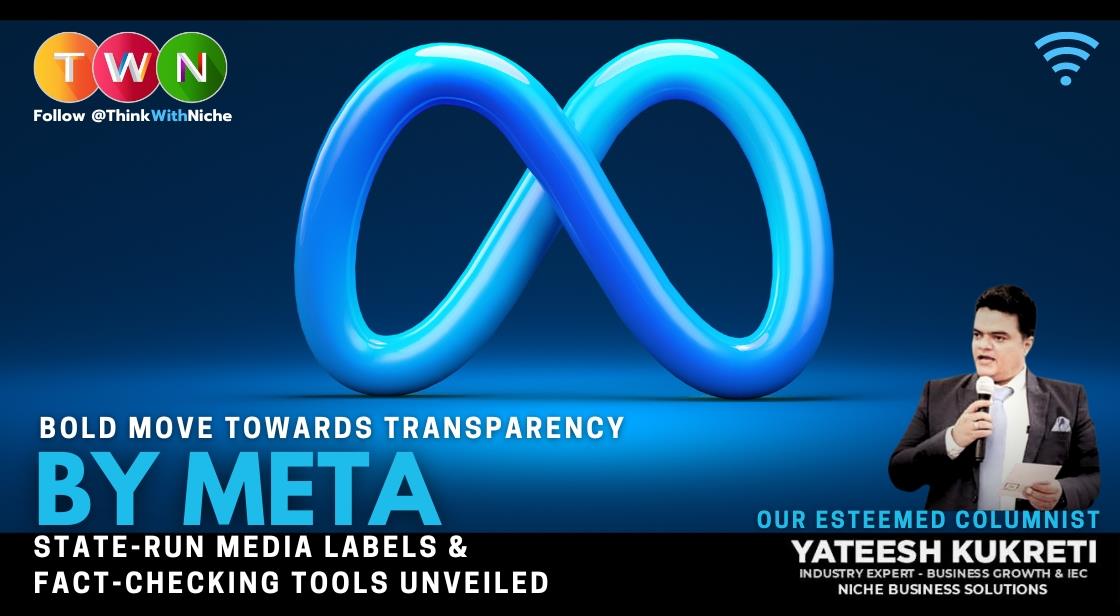Bold Move Towards Transparency by Meta-State-Run Media Labels and Fact-Checking Tools Unveiled

Blog Post
In the rapid-fire digital age, distinguishing between genuine news sources and misinformation-spreading entities is increasingly complex. The situation is further complicated by state-run media outlets, often perceived as vehicles for manipulating public opinion.
Addressing this challenge head-on, Meta (Facebook's parent company) has introduced a novel plan to foster transparency within its platforms. This initiative involves the implementation of labels for state-run media and the roll-out of fact-checking tools for online threads.
As we delve deeper into Meta's strategies, we'll examine their potential implications on our online news consumption, discussing the benefits, potential drawbacks, and the transformation they might bring about in the media landscape.
Ultimately, the objective is to empower users with accurate information, fostering transparency and accountability within the digital media realm.
In this blog post, we explored Meta's plan to promote transparency through the introduction of labels for state-run media and fact-checking on threads.
As social media platforms continue to play a significant role in shaping public opinion, it is crucial to ensure that users have access to accurate information and are aware of the source of the content they consume.
By implementing these measures, Meta aims to empower users to make informed decisions and foster a more transparent digital landscape.
We look forward to witnessing the positive impact of these initiatives as they are implemented and hope that other platforms follow suit in prioritizing transparency and accountability.
In today's digital age, it can be difficult to distinguish between genuine news sources and those that are designed to spread propaganda. This problem is compounded by the rise of state-run media outlets, which are often used to manipulate public opinion.
To combat this issue, Meta, the parent company of Facebook, has announced a new plan to promote transparency in media. This plan includes the introduction of labels for state-run media and the implementation of fact-checking tools on threads.
In this blog post, we will explore the details of Meta's new transparency plan and how it could impact the way we consume news and information online.
We will also discuss the potential benefits and drawbacks of this plan and its implications for the future of media.
Unveiling Meta's Transparency Initiative: A Comprehensive Plan
Introduction to Meta's plan for transparency in media
In an era where information spreads at lightning speed, it has become increasingly important to ensure transparency and accuracy in media. Recognizing this need,
Meta, the parent company of Facebook, Instagram, and WhatsApp, has unveiled its plan to promote transparency by introducing labels for state-run media and implementing fact-checking on threads.
The goal of Meta's plan is to empower users with the ability to identify and evaluate the sources of information they encounter on its platforms.
By implementing clear labels for state-run media, Meta aims to provide users with critical context about the origin and potential biases of the content they consume. This will enable users to make more informed decisions about the credibility and reliability of the information they encounter.
Fostering Digital Transparency: Meta's Innovative Fact-Checking and State-Run Media Labeling Initiatives
Additionally, Meta plans to take a proactive approach to combat misinformation by introducing fact-checking on threads. This means that when a user shares a post or engages in a discussion, relevant fact-checking information will be displayed alongside it.
This feature will not only help users distinguish between verified facts and false information but also encourage a culture of critical thinking and responsible sharing.
By introducing these measures, Meta aims to promote a more transparent and accountable media environment. This move is a significant step forward in addressing the challenges posed by the rapid dissemination of information in the digital age.
It underscores Meta's commitment to fostering an online space that prioritizes accuracy, integrity, and user empowerment.
In the next sections, we will delve deeper into the specific details of Meta's plan and explore how these initiatives can contribute to a more transparent media landscape.
Stay tuned to discover how Meta's efforts can shape the way we consume and interact with information in the digital realm.
Understanding the Impact of State-Controlled Media
The importance of transparency in the digital age
In today's digital age, where information flows freely and rapidly across various platforms, the importance of transparency cannot be overstated.
With a multitude of news sources, social media accounts, and online platforms, it has become increasingly difficult for individuals to distinguish between reliable information and misleading content.
This lack of transparency poses a significant challenge to society, as it can fuel the spread of misinformation and undermine trust in the media.
Transparency plays a pivotal role in fostering accountability and trust. It allows individuals to make informed decisions based on accurate and reliable information.
Without transparency, the credibility of news sources and information providers can be called into question, leading to widespread scepticism and doubt.
In response to these challenges, Meta has recognized the need to promote transparency in its platforms. One of the key initiatives is the introduction of labels for state-run media.
By clearly indicating the affiliation of certain media outlets with government entities, Meta aims to provide users with crucial context about the source of the information they consume.
This transparency empowers individuals to critically evaluate the content they encounter and make informed judgments regarding its credibility and potential biases.
Additionally, Meta's plan to incorporate fact-checking on threads further enhances transparency. This feature enables users to access fact-checking information directly within the platform, making it easier to verify the accuracy of claims and debunk false information.
By integrating fact-checking into the browsing experience, Meta is taking proactive steps to combat the spread of misinformation and promote a more transparent digital environment.
In conclusion, transparency is vital in the digital age to ensure the dissemination of accurate and reliable information. Meta's commitment to promoting transparency through the introduction of labels for state-run media and fact-checking on threads is commendable.
By providing users with the necessary tools to assess the credibility of information, Meta is actively working towards a more transparent and trustworthy online ecosystem.
Meta's Pioneering Response: Introducing Labels for State-Controlled Media
State-run media and its implications
State-run media refers to media outlets that are directly owned or controlled by the government. In many countries, state-run media plays a significant role in shaping public opinion and disseminating information.
However, the implications of state-run media can be complex and have far-reaching consequences.
One of the main concerns with state-run media is the potential for biased reporting and propaganda. As the government has control over these outlets, there is a risk that information may be manipulated or censored to serve political agendas.
This can lead to a lack of objectivity and transparency in news reporting, which is essential for a healthy democracy.
Furthermore, state-run media can limit the diversity of voices and perspectives available to the public. Independent journalism and alternative viewpoints are crucial for a well-informed society. When state-run media dominates the media landscape, it can suppress dissenting opinions and stifle the free exchange of ideas.
Another issue is the blurred line between the government and the media. State-run media can be used as a tool for propaganda and political control, blurring the boundaries between journalism and political messaging.
This can erode public trust in the media and undermine its credibility.
To address these concerns, Meta has proposed the introduction of labels for state-run media to promote transparency. By clearly identifying state-run media outlets, users can be aware of the potential biases and consider alternative sources of information.
This labelling system aims to empower users to make informed choices about the news they consume and encourage a diverse media landscape.
Additionally, Meta's plan includes fact-checking on threads to combat the spread of misinformation. By providing fact-checking information directly within the platform, users can access reliable and accurate information, helping to counteract the influence of false or misleading content.
Promoting transparency in media is crucial for a well-functioning democracy. By addressing the implications of state-run media and implementing measures to promote accountability and fact-checking, Meta aims to contribute to a more informed and empowered society.
Also Read: Exploring the Top Tech Trends of 2023: What You Need to Know
Unpacking the Implementation Strategy for State-Controlled Media Labels
Meta's solution: Labels for state-run media
To promote transparency and combat the spread of misinformation, Meta has unveiled its plan to introduce labels for state-run media. With the rise of social media platforms as primary sources of news for many individuals, it has become increasingly crucial to provide users with clear information about the sources behind the content they consume.
Under this new initiative, state-run media organizations will be required to disclose their affiliations, enabling users to make more informed decisions about the credibility and potential biases of the information being presented.
These labels will serve as visual cues, allowing users to easily identify state-controlled media outlets while scrolling through their feeds.
By implementing these labels, Meta aims to foster a more transparent digital environment, empowering users to critically evaluate the information they encounter.
This step aligns with Meta's commitment to combat misinformation and enhance the overall user experience on its platform.
The introduction of labels for state-run media is an important step towards promoting transparency in an era where disinformation can spread rapidly.
By providing users with clearer visibility into the origins of news content, Meta seeks to encourage a more discerning approach to consume information and empower individuals to navigate the digital landscape more effectively.
Furthermore, these labels will also catalyze fostering open discussions and healthy debates. Users will be able to engage with content from state-run media outlets while being aware of their affiliations, enabling them to approach the information with a more critical mindset and seek alternative perspectives.
Meta's commitment to promoting transparency through the introduction of labels for state-run media is a significant stride towards creating a more reliable and trustworthy digital ecosystem.
By encouraging transparency and empowering users with crucial information about the sources behind the news they consume, Meta aims to foster a more informed and engaged online community.
Unpacking the Implementation Strategy for State-Controlled Media Labels
How labels for state-run media will be implemented
Meta's plan to promote transparency includes the implementation of labels for state-run media. This initiative aims to provide users with clear and easily identifiable information about the source of the content they are consuming.
By labelling state-run media, Meta intends to enhance transparency and enable users to make more informed decisions about the reliability and bias of the information they encounter.
To implement these labels, Meta will develop a comprehensive system that can accurately identify and verify state-run media outlets. This system will take into account various factors, such as ownership, funding sources, and editorial control. By utilizing a combination of artificial intelligence and human review processes, Meta aims to ensure the accuracy and effectiveness of these labels.
Once implemented, users will see a prominent label on posts, articles, or videos originating from state-run media sources. This label will indicate that the content is produced or influenced by a government entity.
By displaying this information, Meta aims to provide users with critical context and empower them to critically evaluate the content they consume.
It is important to note that these labels are not intended to censor or suppress state-run media content.
Instead, they serve as a tool to promote transparency and enable users to make their judgments about the credibility and potential biases associated with state-run media sources.
Additionally, Meta plans to collaborate with third-party fact-checkers to provide users with accurate and reliable information on contentious subjects. By incorporating fact-checking on threads, Meta aims to counter the spread of misinformation and provide users with reliable sources of information.
Through the implementation of labels for state-run media and fact-checking on threads, Meta is taking proactive steps towards fostering transparency and empowering users to make informed decisions in today's digital landscape.
This commitment to transparency aligns with Meta's overarching mission to create a safer, more trustworthy online environment for its users.
Fact-Checking: A Powerful Tool for Ensuring Transparency
The role of fact-checking in promoting transparency
Fact-checking plays a crucial role in promoting transparency, especially in today's digital age where information spreads rapidly and often without proper verification. As part of its plan to promote transparency, Meta has recognized the importance of fact-checking and has taken steps to incorporate it into its platform.
By implementing fact-checking on threads, Meta aims to provide users with accurate and reliable information. This feature will help combat the spread of misinformation, false claims, and fake news by highlighting verified and fact-checked content.
Users will be able to distinguish between reliable information and potentially misleading or inaccurate statements, allowing them to make informed decisions based on accurate data.
Moreover, fact-checking serves as a vital tool to hold state-run media accountable. By labelling state-run media outlets, Meta ensures that users are aware of the source and its potential biases. This transparency empowers individuals to critically evaluate the information they consume, considering the potential influence and agenda behind it.
Meta's commitment to promoting transparency through fact-checking demonstrates its dedication to providing a trustworthy and reliable platform for users. By incorporating this feature, Meta encourages responsible information sharing, fosters a more informed online community, and contributes to the fight against misinformation.
With fact-checking at the forefront, Meta strives to create an online environment where accuracy and transparency prevail.
Exploring Meta's Approach to Fact-Checking on Social Threads
Meta's plan for fact-checking on threads
In its ongoing efforts to promote transparency and combat the spread of misinformation, Meta has introduced a new plan for fact-checking on threads. This initiative aims to provide users with accurate and reliable information while engaging in online discussions and conversations.
With the proliferation of information on social media platforms, it has become increasingly challenging for users to discern between truth and falsehood. Meta recognizes the importance of addressing this issue and is taking proactive steps to ensure that users have access to verified information.
Under this plan, Meta will collaborate with reputable fact-checking organizations to review and verify the accuracy of content shared within threads. When a user posts a potentially contentious or misleading claim, Meta's fact-checking algorithm will detect it and prompt the user with a fact-check label.
The fact-check label will provide users with additional context and information related to the claim being made. It will include a summary of the fact-checking organization's findings, highlighting whether the claim is true, false, or partially true.
This empowers users to make informed decisions about the credibility of the information being shared.
By implementing fact-checking on threads, Meta aims to foster a more transparent and trustworthy online environment. Users will be able to rely on verified information and have a clearer understanding of the accuracy of claims made within discussions.
This initiative not only serves to combat misinformation but also encourages responsible sharing and critical thinking among users.
Meta is committed to continuously improving its fact-checking algorithms and collaborating with fact-checking organizations to ensure the highest level of accuracy and reliability.
Through this ongoing effort, Meta aims to support an informed and engaged online community, where users can rely on credible information and make well-informed decisions.
As Meta continues to prioritize transparency and accountability, this plan for fact-checking on threads represents another step forward in the company's commitment to creating a safer and more trustworthy online space.
User Advantages: How Fact-Checking and State Media Labels Enhance Information Consumption
The benefits of fact-checking and labels for users
Fact-checking and labels for users can have numerous benefits when it comes to promoting transparency in media and online discussions. In today's digital age, where information can spread rapidly and misinformation can easily be disseminated, it is crucial to provide users with accurate and reliable information.
One of the primary benefits of fact-checking is to ensure that users are presented with verified and trustworthy content. By having dedicated fact-checkers who thoroughly assess the accuracy of articles, news reports, and social media posts, users can have confidence in the information they consume.
This helps to combat the spread of false or misleading information, reducing the potential for confusion and misinformation.
Labels for state-run media also play a vital role in transparency. These labels allow users to identify when a source is affiliated with a government or a specific political entity.
By providing this information upfront, users can better understand the potential biases or agendas associated with the content they are consuming. This empowers them to critically analyze the information and make informed decisions about its credibility.
Moreover, fact-checking and labels promote accountability and responsible journalism. When media outlets and individuals are aware that their content will be fact-checked and potentially labelled, they are more likely to conduct thorough research, verify their sources, and present accurate information.
This contributes to a higher standard of journalism and helps build trust between media organizations and their audience.
Additionally, fact-checking and labels can foster healthy discussions and debates online. When users have access to accurate information and are aware of potential biases, they can engage in more constructive conversations.
It becomes easier to challenge misinformation and present evidence-backed arguments, leading to a more informed and productive exchange of ideas.
Potential Hurdles and Solutions in Meta's Transparency Journey
Addressing potential challenges and concerns
While Meta's plan to promote transparency through labels for state-run media and fact-checking on threads is a step in the right direction, it is important to address potential challenges and concerns that may arise.
One potential challenge is determining the criteria for labelling state-run media. Differentiating between state-run media and independent news sources can be a complex task, as some media outlets may have ties to the government while still maintaining some level of editorial independence.
It will be crucial for Meta to establish clear guidelines and ensure transparency in the process of labelling state-run media to avoid any biases or misinterpretations.
Another concern is the potential for false fact-checking or biases in the fact-checking process. While fact-checking is an essential tool in combating misinformation, it is imperative to have robust systems in place to ensure the accuracy and impartiality of the fact-checkers.
Meta should invest in a diverse pool of fact-checkers with expertise in various fields to minimize any potential biases and ensure comprehensive and accurate fact-checking.
Additionally, there may be concerns regarding the impact on freedom of speech and the potential for censorship. Meta must strike a balance between promoting transparency and avoiding any undue limitations on free expression.
Transparent communication and involvement of relevant stakeholders, such as journalists, media organizations, and civil society, will be key in addressing these concerns and ensuring that the implementation of these measures is fair and equitable.
By establishing clear guidelines, ensuring accuracy in fact-checking, and promoting an inclusive and transparent process, Meta can navigate these challenges and promote a more informed and accountable digital space.
Looking Ahead: The Promising Future of Media Transparency with Meta
Conclusion and the Future of Transparency in Media
In conclusion, Meta's plan to promote transparency in media is a significant step towards fostering a healthier information ecosystem. By introducing labels for state-run media and implementing fact-checking measures on threads, Meta aims to empower users with the ability to make informed decisions about the content they consume.
However, this is just the beginning. The future of transparency in media holds immense potential for further advancements and improvements. As technology continues to evolve, platforms like Meta must adapt and stay ahead of the curve.
One possible direction for the future is the development of more sophisticated algorithms and artificial intelligence systems that can better detect and flag misinformation. This would not only help in reducing the spread of false information but also enable users to access credible sources more easily.
Additionally, collaboration between social media platforms, fact-checking organizations, and governments can play a vital role in combating misinformation. By working together, they can establish standardized fact-checking processes, share resources, and ensure that accurate information reaches the masses.
Another aspect to consider is the education of users. Promoting media literacy and critical thinking skills can empower individuals to discern between reliable and unreliable sources, enabling them to make more informed decisions when consuming news and information.
Ultimately, the future of transparency in media relies on the collective efforts of technology companies, governments, fact-checkers, and users. It requires a shared commitment to upholding the principles of accuracy, accountability, and integrity in the digital realm.
As Meta continues to refine its strategies for promoting transparency, users need to remain active participants in the media landscape. By staying vigilant, questioning information, and engaging in constructive conversations, we can all contribute to a more transparent and trustworthy media environment.
You May Like
EDITOR’S CHOICE












